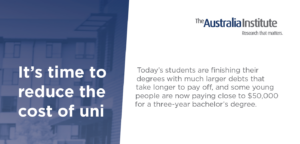People are starting with much larger HECS/HELP debts than in the past – and it is only going to get worse
Australians in their 20s have HECS/HELP debts more than $10,000 greater in real terms than did people 20 years ago
HECS/HELP no longer operates as it was supposed to. What was intended to be a modest contribution to the cost of higher education repaid once you earned nearly 90% of average earnings is now saddling Australians with large debts that they are repaying when they earn barely more than the minimum wage.
The line is often made that because HECS/HELP loans are indexed to inflation there is no need to worry about the debt because it is “in effect” interest-free.
The reality is that because inflation has risen faster than wages over the past two years many people on lower-incomes with HECS/HELP debt have larger debts now than they did in 2022. But even this ignores that the rising costs of higher education tuition fees mean that Australians on leaving university now have much higher levels of debt than did graduates 10 or 20 years ago (let alone those who graduated back in the early 1990s when HECS began).
The ATO data shows that Australians in their 20s with a HECS/HELP debt in 2005-06 had an average debt of $12,557. From then till June 2023 inflation increased 57%, which would mean that had the average size of debt increased in line with inflation the average 2022-23 HECS/HELP debt held by people in their 20s should be $19,546 – instead average debt has risen by 145% and is $30,763.
The problem with the HECS/HELP system is not just that indexation has been so great in recent years as to lead to the increase of debt for some people even after repayments, but that the debt burdens being taken on by university graduates are far greater than was intended when HECS was introduced.
Worse still is that these figures do not take into account the impact of the increased costs of HECS/HELP for students due to the changes made by Scott Morrison in 2021. These changes for example saw the costs of a Communication Degree rise from around $20,400 to $43,500.
As students paying these costs graduate the average level of HECS/HELP debt is set to soar to the point where even an average of a $30,000 debt for someone in their 20s will be viewed with nostalgic envy.
Government budgets are about choices. Right now the government is choosing to spend $50bn on defence. Removing indexation on HECS/HELP would cost by comparison just $1.3bn-$1.5bn a year.
Between the Lines Newsletter
The biggest stories and the best analysis from the team at the Australia Institute, delivered to your inbox every fortnight.
You might also like
It’s time to reduce the cost of university
Today’s students are finishing their degrees with much larger debts that take longer to pay off, and some young people are now paying close to $50,000 for a three-year bachelor’s degree.
Five reasons why young Australians should be pissed off
1. Uni graduates pay more in HECS than the gas industry pays in PPRT University used to be free but is now more expensive than ever. After graduating with an arts degree a young Australian will now repay the government around $50,000. Meanwhile, Australia is one of the world’s largest gas exporters, but multinational gas
In 2023-24 Australians paid more than 4 times on HECS/HELP than gas companies did on PRRT
In 2023-24 tax from the PRRT was less than an quarter the amount raised by HECS/HELP debts repayments.


